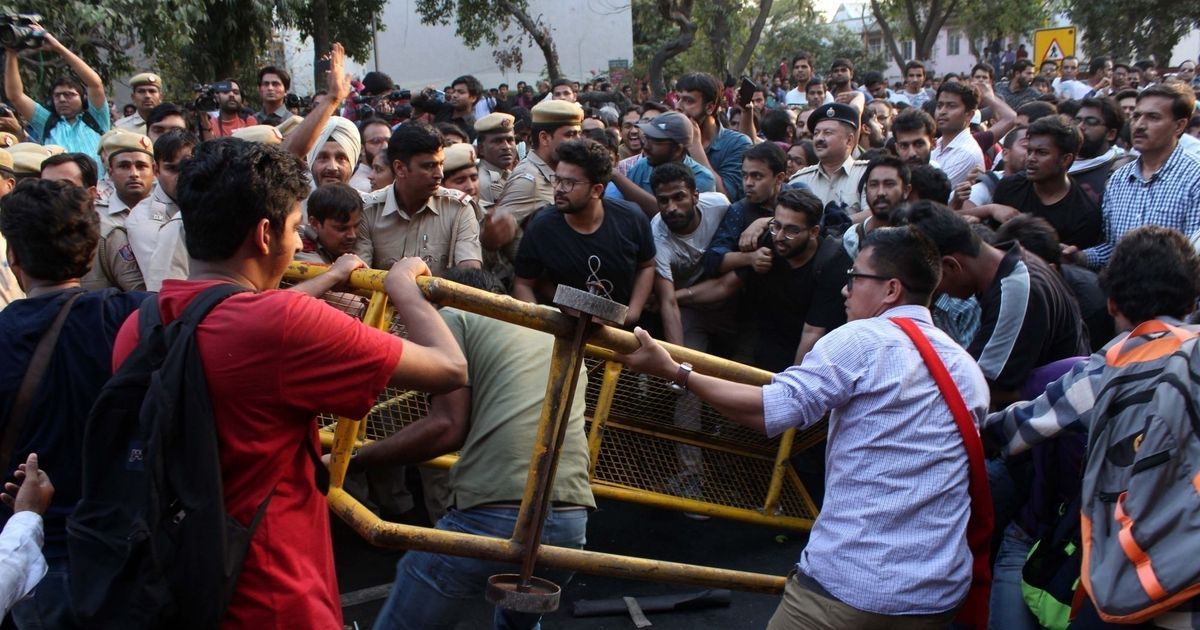The JNU Long March on 23rd March 2018 from the Jawaharlal Nehru University (JNU) campus to Parliament Street faced a nasty and atrocious reception from the police. More than a thousand students and members of JNU Teachers’ Association (JNUTA) were part of this protest against compulsory attendance, autonomy and lack of administrative actions against Professor Atul Johri. The treatment that the protesters were meted entailed water cannons, lathi charge, and sexual harassment.
It is ironic to witness such behaviour by the police, when in fact the protest itself was held against sexual harassment.
Professor Johri, from the School of Life Sciences (SLS), was accused of sexual harassment by 8 students. An FIR was registered against him on 16th of March to Delhi police after 96 hours of protest by the students. Within 80 minutes of his arrest, he was set free on bail.
The students who were protesting against this have allegedly been threatened to withdraw their complaint against Johri. JNU has been embroiled in controversy for many different reasons and Atul Johri’s incident has turned up the heat.
In recent times when social media platforms have been flooded with the discussion around the #MeToo campaign; the debates around name calling and due process have taken pivotal positions in the entire discourse. The problems with due process have never been clearer here, where a man accused of harassment by 8 students has been let free on bail.
Another pressing issue of protest in the JNU Long March was about the autonomy granted by the University Grants Commission (UGC) to universities and colleges as declared on 19th March 2018. The privatization of colleges and universities, as proposed by the central government, makes higher education unaffordable for the wide majority of students in India.
The long march, however, was halted at INA Market. The police unleashed water cannons on the protestors and began to manhandle several protesters and journalists. Delhi Cantonment Station House Officer Vidyadhar Sing has been accused of pushing a female journalist by placing his hand on her chest. She also was heard requesting him not to break her camera.
See How @DelhiPolice is treating the protesters . Police has beaten the students after arresting them .. #JNULongmarch #JNU #Jnuprotest @Live_Hindustan pic.twitter.com/1ipI61ZAjt
— Hemant Rajaura (@hemantrajora_) March 23, 2018
The police authorities have since addressed this issue with a clumsy apology where the Delhi Police chief spokesperson said, “In the confusion, some female police personnel mistook a photojournalist as a protester. While that is still not an excuse, I would like to stress it was completely by accident.” However, they have since suspended two officers for “unprofessional conduct” due to the incident.
It is ironically very shameful to witness such atrocious behaviour by the police, when in fact the protest was held against an incident of sexual harassment itself. In the recent debates around sexual harassment, ‘power dynamics’ has been an important point of argument in order to understand that how a gesture or an act can be read as sexual harassment of a student by a professor. Beyond student-professor dynamics, the regressive behaviour of the police (which works an apparatus of state and power) shows how power dynamics between the powerful and powerless can work in whichever circumstances.
The atrocities by police and government authorities and the administrative bodies consistently display the miserable condition of social justice and equity of present times.
Featured Image Credit: Scroll
About the author(s)
Gender Fluid. Queer. Feminist. Activist. Writer. Poet. Dreamer.




